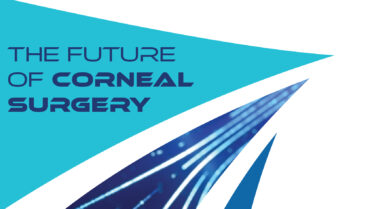

LASIK and PRK are among the most commonly performed surgical procedures worldwide.1,2 A novel laser vision correction technology known as laser-induced refractive index change (LIRIC; Clerio Vision) has the potential to revolutionize corneal refractive surgery. In this tissue-sparing method, a femtosecond laser is used to correct corneal aberrations, including myopia, hyperopia, and mixed astigmatism. Unlike corneal excimer ablation, LIRIC modifies the corneal refractive index.3
Overview
Mechanism and application. LIRIC modifies the cornea’s refractive properties by altering its fibril density without removing or disrupting collagen. The laser operates at a wavelength of 405 nm,4,5 and the absorption process leads to highly localized refractive index alterations in the anterior corneal stroma.6 Low pulse energy and a high repetition rate denature collagen fibers and dehydrate the treated area. LIRIC can treat both sphere (-3.00 to +1.50 D) and cylinder (up to -1.50 D).7 In an animal model, the effects of LIRIC on the cornea persisted for up to 2 years.5
Corneal treatment. LIRIC alters the stroma at a depth of 10 µm without thinning or changing the anterior corneal surface. Repeat procedures are therefore possible to address changes in vision over time. Refractive indexing may have a number of potential advantages compared to traditional excimer laser ablation.
Is Refractive Index Shaping the Next Step in Vision Correction?
Excimer laser vision correction and keratorefractive lenticule extraction are among the safest procedures in medical history.8,9 A key advantage of refractive index shaping is the ultraminimally invasive nature of the procedure. As a nonablative procedure, myofibroblast differentiation and inflammatory cell migration are minimal.10 Refractive index shaping seems to have a reduced inflammatory cascade, thereby decreasing the rare occurrence of haze. Bench studies have found no significant inflammatory response, as evidenced by the absence of neutrophils, lymphocytes, and macrophages in treated corneal areas.6
Patient comfort and recovery. During LIRIC, the corneal epithelium remains intact, which reduces postoperative patient discomfort compared to PRK and eliminates the need for postoperative antibiotics or steroids.6 In preliminary studies, scientists saw quicker recovery and less discomfort with LIRIC versus PRK.6,11
Biomechanical stability. No flap is created during LIRIC, and no tissue is ablated. The preservation of corneal biomechanics makes the procedure suitable for patients with borderline topography or thin corneas. OCT imaging has shown no short- or long-term changes in corneal thickness,6 which could broaden the range of candidates for treatment.
Nerve preservation and patient satisfaction. No changes in the subbasal or stromal nerve layers were found after LIRIC in a rabbit model.6 The procedure could cause less temporary ocular surface discomfort than traditional laser vision correction, potentially enhancing overall patient satisfaction.
Clinical Trials and Outcomes
Long-term studies are necessary to evaluate the stability and safety of the refractive changes after LIRIC. Safety outcomes in the first human clinical trial were promising.11 In the study, patients with preexisting low vision received +2.50 D diffractive bifocal wavefront treatment. Postoperatively, they gained at least 2 lines of near vision without losing distance vision. All corneas remained clear with no evidence of haze, scarring, or endothelial injury. The LIRIC pattern was visible at the slit lamp and in OCT images. No significant changes in anterior or posterior corneal curvature or thickness were observed.
IOL applications. Refractive index shaping technology similar to that for LIRIC has been applied to IOLs. With the Perfect Lens system (Perfect Lens), low femtosecond laser energy is applied to an IOL to alter its refractive index, modifying the lens’ hydrophilicity.12 Multiple adjustments can be made to the same IOL, potentially allowing it to be customized to suit the patient’s preferences without additional surgery.
It is theoretically possible to adjust an IOL’s spherical power and add multifocality to the lens with the Perfect Lens and LIRIC technologies.13 This could greatly benefit patients who are dissatisfied with their vision or depth of focus after cataract surgery.
Looking Ahead
Refractive indexing technology is promising. Although the technology is in its infancy, its potential benefits are exciting. LIRIC and related technologies may transform laser vision correction.
1. M, Gatinel D, Reinstein DZ, Mertens E, Alió Del Barrio JL, Alió JL. Refractive surgery beyond 2020. Eye (Lond). 2021;35(2):362-382.
2. Ambrósio R, Machado AP, Leão E, et al. Optimized artificial intelligence for enhanced ectasia detection using Scheimpflug-based corneal tomography and biomechanical data. Am J Ophthalmol. 2023;251:126-142.
3. Ferrer A, Jaque D, Siegel J, De La Cruz AR, Solís J. Origin of the refractive index modification of femtosecond laser processed doped phosphate glass. J Appl Phys. 2011;109(9).
4. Ding L, Knox WH, Bühren J, Nagy LJ, Huxlin KR. Intratissue refractive index shaping (IRIS) of the cornea and lens using a low-pulse-energy femtosecond laser oscillator. Invest Ophthalmol Vis Sci. 2008;49(12):5332-5339.
5. Savage DE, Brooks DR, Demagistris M, et al. First demonstration of ocular refractive change using blue-iris in live cats. Invest Ophthalmol Vis Sci. 2014;55(7):4603-4612.
6. Wozniak KT, Butler SC, He X, Ellis JD, Knox WH, Huxlin KR. Temporal evolution of the biological response to laser-induced refractive index change (LIRIC) in rabbit corneas. Exp Eye Res. 2021;207:108579.
7. Mercer RN, Milliken CM, Waring GO 4th, Rocha KM. Future trends in presbyopia correction. J Refract Surg. 2021;37(S1):S28-S34.
8. Kim TI, Alió Del Barrio JL, Wilkins M, Cochener B, Ang M. Refractive surgery. Lancet. 2019;393(10185):2085-2098.
9. Fuest M, Mehta J. Advances in refractive corneal lenticule extraction. Taiwan J Ophthalmol. 2021;11(2):113-121.
10. Wilson SE, Sampaio LP, Shiju TM, Hilgert GSL, de Oliveira RC. Corneal opacity: cell biological determinants of the transition from transparency to transient haze to scarring fibrosis, and resolution, after injury. Invest Ophthalmol Vis Sci. 2022;63(1):22.
11. Zheleznyak L, Butler, SC, Cox IG, et al. First-in-human laser-induced refractive index change (LIRIC) treatment of the cornea. Invest Ophthalmol Vis Sci. 2019;60(9):5079.
12. Werner L, Ludlow J, Nguyen J, et al. Biocompatibility of intraocular lens power adjustment using a femtosecond laser in a rabbit model. J Cataract Refract Surg. 2017;43(8):1100-1106.
13. Bille JF, Engelhardt J, Volpp HR, et al. Chemical basis for alteration of an intraocular lens using a femtosecond laser. Biomed Opt Express. 2017;8(3):1390-1404.


